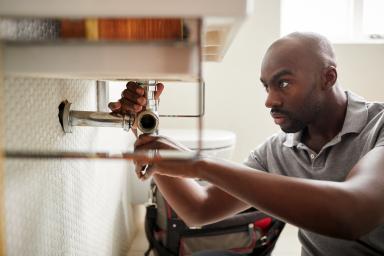Create a healthy work environment for employees
Creating a healthy work environment is good for employees and it can give your start-up business a productivity boost too.
Healthy working doesn't need to cost the earth. Simple changes such as providing free fruit and water can dramatically improve workplace health.
Why create a healthy work environment?
A healthy work environment can reduce the amount of time lost to sick days, improve staff morale and lead to more productive and creative approaches to work.
For a start up with fewer staff, keeping staff engaged and motivated while not chalking up needless sick days makes financial sense.
According to the Office of National Statistics (ONS), there were 131m working days lost to sickness in 2017 - with just over 34m lost to minor ailments such as coughs and colds.
Sick days cost the economy £13.4bn in lost productivity according to the National Institute for Health and Care Excellence (NICE).
It isn't just about preventing your work environment becoming a hotbed of coughs and colds.
Around 1-in-3 employees live with a long-term health condition, according to Public Health England, with 1-in-8 employees reporting living with a mental health condition.
Without proper support in the workplace, 42% of employees felt that their condition affected their work ‘a great deal' or ‘to some extent'.
Some workspace improvements are required by law.
For example, you must conduct workplace risk assessments for new or expectant mothers, including during pregnancy and for six months post birth or while the employee is still breastfeeding.
The Health and Safety Executive has a useful guide to conducting a workplace risk assessment.
You'll also need to conduct regular desk assessments for employees using monitors and displays, such as laptops.
The Health and Safety Executive offers a workstation assessment guide, as well as information on providing health support such as eye checks if an employee requests one.
How to create a healthy work environment
Creating a productive, healthy and active work environment needn't be expensive.
Office planning, noise management and the overall environment such as lighting and foliage can make a difference.
The trick is to actively plan a healthy work environment.
That means thinking about how staff work, creating areas for quiet focus or more group-based working, and ensuring seating is away from noisy distractions such as office photocopiers.
A healthy work environment isn't limited to physical changes, either.
Adopt an adaptable approach by offering flexible working hours or the ability to work from home to boost productivity.
Employees suffering from a minor ailment are likely to be more productive working from home, while not introducing illness into the workplace.
There are plenty of ways to improve your working environment.
Cheap solutions include adding plants and foliage through to buying ergonomic furniture.
1. Plan for a healthy work environment
Take time to figure out how employees will work together and where they should sit.
Look at high traffic areas as these can be distracting for those sat at nearby desks.
Create comfortable working spaces.
Desks should be positioned to enable staff to work together, but not positioned too densely.
Consider zoning dedicated breakout areas, quiet spaces, meeting areas and eating areas.
Flexible working areas where walls can be repositioned to create larger spaces are worth considering.
Add plants to Improve air quality and break up the corporate environment.
Choose leafy green plants but don't add too many.
Upgrading air conditioning with a high efficiency particulate air (HEPA) filter can remove pollutants and allergens from the air, helping staff breathe a little easier.
Ensure the office is a comfortable temperature and at the right humidity level - regularly check that staff are neither too hot or cold and be prepared to move desks that are too close to air conditioning units.
Some work environments such as motor vehicle repair and maintenance, workshop and kitchens may have specific requirements that you need to be aware of in order to ensure a healthy work environment.
Find out more on the Health and Safety Executive website.
2. Use office lighting carefully
Working in a dimly lit office can lead to headaches and lack of concentration.
Invest in good-quality lighting - artificial lighting that simulates daylight can transform an office.
A study by the Institute of Lighting Professionals found that switching from standard white lighting to artificial daylight lighting in an office reduced headaches and eye strain, and improved alertness.
Flickering bright lighting may cause migraines according to the NHS. Ensure desks are well-lit and include a desk lamp. Some employees could benefit from a dedicated lamp to combat Seasonal Affective Disorder (SAD), which may be caused by lack of sunlight especially during autumn and winter.
3. Invest in ergonomic workstations
Long days spent hunched over a laptop or keyboard can spell bad news to employee health.
Poor posture, circulation and a lack of focus can result from poorly positioned screens and office seating.
The Health and Safety Executive provides a display screen safety leaflet with information about the assessments you need to legally carry out to ensure employees can work comfortably.
Buy support items such as ergonomic office chairs with lumbar support, anti-glare filters for screens and wrist rests for keyboards to reduce the risk of repetitive strain injury (RSI).
Regularly assess workstations and ensure staff are educated on the correct positioning of screens, phones and keyboards.
Standing desks are increasingly popular, and allow employees to work either standing or seating, helping improve posture and circulation.
4. Tackle distracting office noise
Noisy offices and workspaces are a major source of a drop in productivity and can lead to significant hearing loss according to a report by the Health and Safety Executive.
Ensure noise is kept to a minimum, including positioning equipment such as photocopiers and printers away from desks.
Create quiet areas and encourage staff to use headphones rather than play loud music in the office.
If undertaking renovation or maintenance work, schedule it outside of working hours.
5. Offer staff healthy food choices
Ditch the chips and cut down on the cakes.
As tempting as it is to allow staff to bring in tray bakes and packets of sweets to share, offices can soon resemble an unhealthy tuck shop.
Consider offering weekly fruit baskets for staff instead - expect to pay around £5 per employee per week - as well as free filtered water and fruit teas to keep staff hydrated.
6. Promote employee wellbeing
A healthy work environment is more than investing in ergonomic equipment.
Culture plays a huge role, too. Introduce health-friendly schemes that promote healthy living.
This can range from providing information on diet and exercise, to encouraging lunchtime strolls and taking the stairs instead of the lift.
Introduce a cycle to work scheme, which promotes healthy exercise and saves employees money on the cost of a new bicycle - usually around 30%.
Employers save from the scheme too and are able to offset 13.8% of the cost of the benefit against NICs.
A cheap and effective approach to getting employees away from their desk and more active is to hold 1-2-1 meetings while walking outside rather than sat in a meeting room.
7. Take meetings and staff outside
Slap on the sun cream and head outside when possible.
Being stuck indoors and away from sunlight can lead to a lack of vitamin D, which can result to an increased risk of cardiovascular disease according to the British Heart Foundation.
In summer, hold staff meetings in a nearby park, arrange for picnic lunches or encourage staff to walk to and from work to get some exposure to the sun.
8. Offer a flexible work/life balance
A healthy work environment extends beyond the physical space.
Foster a culture of flexible working, allowing employees time and space to work from home or take time off to deal with unexpected emergencies.
If you've a larger business, encourage managers to be flexible about working schedules and challenge restrictive, bad behaviour in the office.
Flexible working can improve the mental wellbeing of staff, reduce stress levels and improve employee engagement.
9. Build a collaborative working environment
Make connectivity easy and banish IT problems. Employees can get frustrated with connectivity issues and stress levels can increase trying to grapple with technology.
Instead of letting ageing technology getting in the way of productivity, invest in modern communication tools such as instant messaging, team-working tools and cloud-based project management services.
Using shared digital storage that can be accessed anywhere, as well as web-based email, calendar and virtual meeting services, can increase overall collaboration and reduce frustrations.
10. Take time to have fun
While work should be about work, that doesn't mean you can't inject a little fun into the workplace.
Fun activities can keep morale up, increase engagement and improve mood.
Fun activities don't need to be major events, either.
Offering staff ice lollies in summer, arranging a staff barbecue, providing relaxation areas with video games or even screening popular season finales of popular TV programmes can foster a sense of inclusion and community.
Learn with Start Up Loans and improve your management skills.
Discover more about managing people with our free online courses in partnership with The Open University on sustainability in the workplace.
Our free Learn with Start Up Loans courses include:
- Effective communication in the workplace
- Managing relationships
- Succeed in the workplace
- Leadership and followership
Plus free courses on climate and sustainability, teamwork, entrepreneurship, mental health and wellbeing.
Disclaimer: The Start -Up Loans Company makes reasonable efforts to keep the content of this article up to date, but we do not guarantee or warrant (implied or otherwise) that it is current, accurate or complete. This article is intended for general information purposes only and does not constitute advice of any kind, including legal, financial, tax or other professional advice. You should always seek professional or specialist advice or support before doing anything on the basis of the content of this article.
The Start-Up Loans Company is not liable for any loss or damage (foreseeable or not) that may come from relying on this article, whether as a result of our negligence, breach of contract or otherwise. “Loss” includes (but is not limited to) any direct, indirect or consequential loss, loss of income, revenue, benefits, profits, opportunity, anticipated savings, or data. We do not exclude liability for any liability which cannot be excluded or limited under English law. Reference to any person, organisation, business, or event does not constitute an endorsement or recommendation from The Start-Up Loans Company, its parent company British Business Bank plc, or the UK Government.
Your previously read articles
Sign up for our newsletter
Just add your details to receive updates and news from Start Up Loans
Sign up to our newsletter


